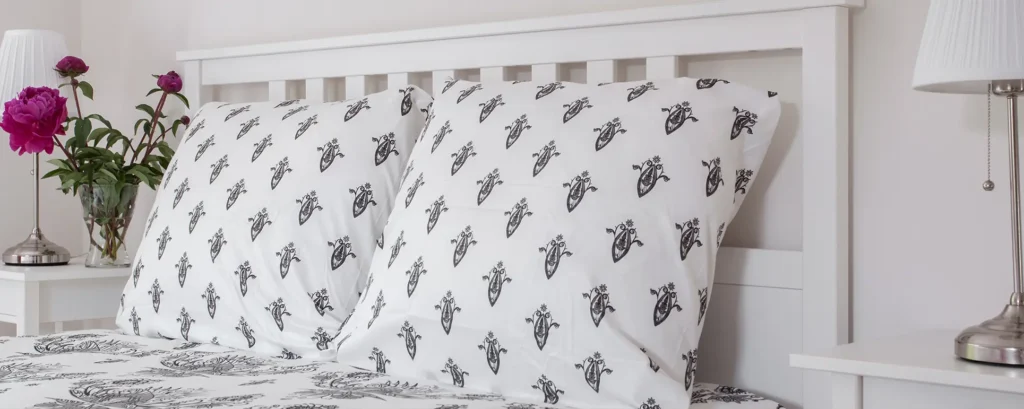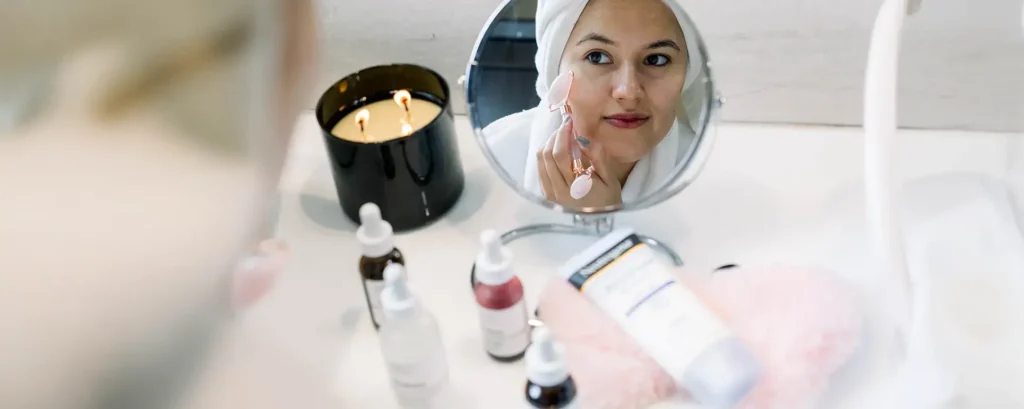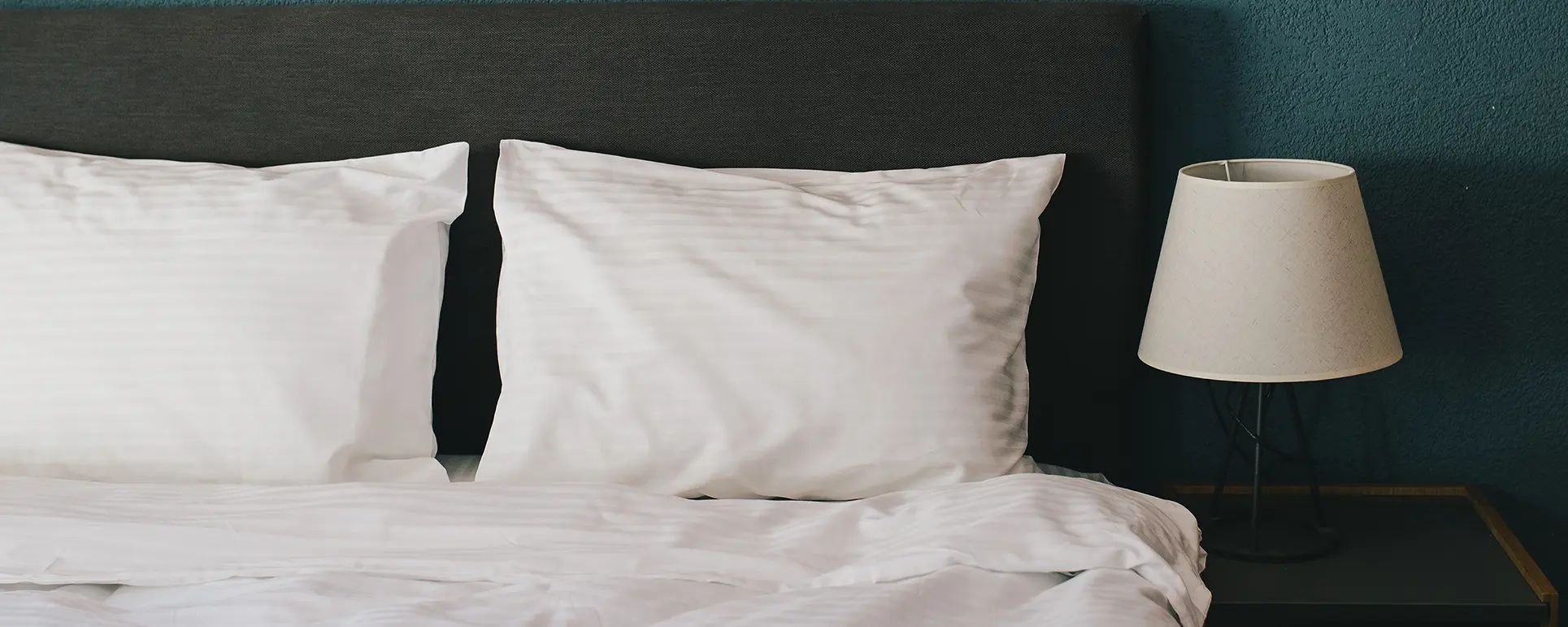We’ve all heard the advice at some point: “If you want clearer skin, change your pillowcase regularly.” It’s one of those tips that pops up in beauty magazines, TikTok skincare hacks, and even casual conversations with friends. But is it actually true? Or is it just another skincare myth that sounds convincing but doesn’t hold up under closer inspection?
When you think about it, the idea makes a lot of sense. Every night, our faces spend hours in direct contact with our pillowcases. That’s six to eight hours sometimes more of skin pressed against fabric that gradually collects oil, sweat, makeup residue, hair products, and even environmental pollutants we bring home with us. If you don’t wash your pillowcase often, you’re essentially sleeping on a build-up of bacteria, dirt, and dead skin cells. It’s not exactly the cleanest environment for your face.
For people with sensitive or acne-prone skin, this can become a bigger issue. Those impurities can transfer back onto the skin, clog pores, and trigger breakouts. Even if you follow a consistent skincare routine, use gentle cleansers, and invest in high-quality serums, a dirty pillowcase might be undermining your efforts without you realising it. In fact, dermatologists often point out that lifestyle habits like how often you change your bedding can play a surprisingly important role in overall skin health.
That said, it’s important to be realistic. Simply swapping out your pillowcase isn’t going to act as a miracle cure for acne, nor will it erase wrinkles or fine lines overnight. Skin health is complex and influenced by many factors genetics, hormones, diet, stress levels, and your skincare regimen, to name a few. However, something as simple as maintaining a clean sleep environment can support your routine and reduce unnecessary irritation. Think of it as one small but effective step you can take towards healthier skin.
In this guide, we’ll explore the science behind the pillowcase-skin connection, what dermatologists really think about this habit, and which types of pillowcase materials are better for your skin. We’ll also look at how often you should be washing or changing your bedding and share practical tips to make this routine easier to stick to.
How Pillowcases Affect Your Skin

When most of us think about skincare, we tend to focus on the obvious things cleansers, toners, serums, and moisturisers. What we rarely consider is the surface our skin spends the most time in contact with: the humble pillowcase. On average, we sleep for around seven to eight hours every night, which means our skin is pressed against that fabric for nearly a third of our lives. That’s a lot of time for bacteria, oils, and friction to influence your complexion, for better or worse.
Even if you wash your face thoroughly before bed, your pillowcase doesn’t start out perfectly fresh. Over time, it becomes a collector of everything your body and environment leave behind sweat, natural oils, shed skin cells, and even particles from hair products and cosmetics. If you’re not washing or changing your pillowcase often, all of that residue lingers on the fabric and creates a cycle where it transfers back onto your skin each night. Here’s how that build-up really affects your complexion
1. Bacteria and Oils: A Breeding Ground for Breakouts
Your skin naturally produces sebum, the protective oil that helps keep it soft and hydrated. But when sebum mixes with sweat, leftover makeup, or dirt from your hair, it clings to your pillowcase. As you sleep, these substances rub back onto your face, creating the ideal environment for bacteria particularly Cutibacterium acnes, the bacteria linked to acne to multiply.
For someone with acne-prone or oily skin, this cycle can be especially troublesome. Even if you follow a meticulous skincare routine, a pillowcase that hasn’t been washed for days may be undoing your efforts by reintroducing pore-clogging grime. It’s why many dermatologists recommend treating bedding hygiene as part of a broader acne-prevention plan, alongside topical treatments and diet management
2. Dead Skin Cells: A Hidden Layer of Build-Up
Skin renewal is a natural, ongoing process. Every day, your body sheds thousands of dead skin cells, many of which end up on your pillow while you sleep. Unlike the visible dust you might notice on furniture, these tiny flakes are practically invisible but they accumulate quickly.
Over several nights, these cells settle into the fabric fibres and mix with oils and sweat. This build-up not only dulls your complexion but can also contribute to clogged pores. For people with sensitive or reactive skin, this extra layer of residue may increase irritation, leading to redness or flare-ups of conditions such as eczema. Regularly switching to a clean pillowcase reduces this risk, giving your skin a cleaner surface to rest on and helping it look fresher.
3. Fabric Friction: The Silent Irritant
The texture of your pillowcase fabric plays a bigger role in skin health than most people realise. Rougher materials, such as low-thread-count cotton or certain synthetic fabrics, can create friction as you move your face across the pillow during the night. This constant rubbing may cause micro-irritation, particularly for individuals with sensitive skin or conditions like rosacea.
Over time, repeated friction might also contribute to the appearance of fine lines or “sleep wrinkles,” which form in areas where the skin is repeatedly pressed and creased against the fabric. On the other hand, smoother fabrics such as silk or satin allow your face to glide more easily, reducing tugging and minimising irritation. That’s why many beauty experts recommend upgrading your pillowcase fabric if you’re concerned about premature ageing or ongoing irritation.
4. Skincare Product Absorption: Wasted Efforts
Have you ever noticed your pillowcase developing faint stains over time? That’s often a result of your night creams, serums, or acne treatments transferring from your skin to the fabric. Pillowcases don’t just collect what comes off your skin; they also absorb some of the very products you’ve invested in to keep your complexion healthy.
Not only does this reduce the effectiveness of your skincare routine since less of the active ingredients stay on your skin but it also adds another layer of residue to your pillowcase, which can eventually lead to irritation. In this way, a dirty pillowcase doesn’t just sabotage your skin directly, it can also undermine the benefits of your skincare investments.
5. Environmental Pollutants and Allergens
It’s not only your skin and hair contributing to pillowcase residue. Fabrics can trap environmental pollutants such as dust, pollen, or smoke particles, particularly if you live in an urban area or keep your windows open at night. For individuals with allergies or asthma, these trapped particles can irritate not only the skin but also the respiratory system. From a dermatological perspective, allergens caught in pillow fibres may worsen conditions like eczema or cause persistent itchiness.
Fabric Matters
Not all pillowcases are created equal, and the material you sleep on each night can play a bigger role in your skin’s health than you might expect. Because your face stays in close contact with the pillowcase for several hours, the texture, breathability, and absorbency of the fabric can either support or undermine your skincare routine. Choosing the right material isn’t about luxury alone it’s about reducing irritation, keeping skin balanced, and helping your products do their job.
Here’s how different fabrics compare:
Cotton
Cotton pillowcases are the most common option and are valued for their breathability. The fibres allow airflow, which can keep your skin cooler overnight and help absorb excess sweat. This makes cotton a good match for people who run hot while sleeping. However, its absorbent nature has a downside it doesn’t just soak up moisture, it can also absorb your serums, moisturisers, or acne treatments. Over time, this not only diminishes the effectiveness of your skincare but can also cause product residue to linger in the fabric, requiring frequent washes. Higher-quality cotton, such as Egyptian or organic cotton, tends to be softer and less abrasive than cheaper weaves, making it kinder to sensitive skin.
Silk or Satin
Silk has become something of a beauty industry favourite, often promoted as the “luxury” option for both skin and hair. Its main advantage lies in its texture silk has a smooth, almost slippery surface that reduces friction. This means less tugging at the skin, fewer creases while you sleep, and reduced irritation for people with rosacea or eczema. Satin, a weave that can be made from silk or synthetic fibres, mimics these benefits at a lower price point. Both materials are less absorbent than cotton, which means your skincare products stay where they should on your skin. While silk pillowcases can be more expensive and require delicate washing, many dermatologists agree they can be worth considering if you’re prone to irritation or are trying to minimise “sleep wrinkles.”
Microfiber
Microfiber pillowcases are made from very fine synthetic fibres, usually polyester. They’re affordable, soft, and easy to find, which makes them popular. But they’re not without drawbacks. Microfiber tends to trap heat and isn’t as breathable as cotton or bamboo. For oily or acne-prone skin, this can be problematic, as the fabric may hold onto sweat and sebum rather than allowing it to evaporate. Over time, this build-up can contribute to clogged pores. That said, for those on a budget or looking for a very soft feel, microfiber can still work provided the pillowcase is washed frequently to keep residue from building up.
Bamboo and Other Alternatives
Bamboo-based fabrics are becoming increasingly popular as a sustainable and skin-friendly option. They’re naturally breathable, hypoallergenic, and often softer than cotton. Some bamboo pillowcases even have antimicrobial properties, which can be helpful for people prone to breakouts or skin sensitivity. Linen, another natural fibre, is exceptionally breathable but tends to have a rougher texture unless pre-softened. While it may be a good option for those who prioritise airflow, people with delicate skin might prefer a smoother fabric like bamboo, silk, or high-thread-count cotton.
Why Fabric Choice Matters
The fabric of your pillowcase influences your skin in several subtle but important ways. Softer fabrics reduce friction and help prevent irritation, while breathable fibres like cotton or bamboo prevent overheating and excess sweating. Less absorbent materials, such as silk or satin, help keep skincare products on your skin instead of being wasted on the pillow.
By choosing a fabric that balances comfort, breathability, and skin-friendliness, you can create a sleep environment that works hand in hand with your skincare routine. While it may seem like a small detail, the right pillowcase can support clearer skin, reduce irritation, and even slow down the development of fine lines linked to sleep habits.
Night-Time Habits That Support Healthy Skin

Changing your pillowcase is a helpful step, but it’s not a miracle solution. Skin health is influenced by many factors, and while a clean sleep environment certainly helps, dermatologists stress that it should be part of a broader night-time routine. What you do before bed can have just as much impact on your complexion as the products you use during the day. By combining pillowcase hygiene with smart bedtime habits, you create the best conditions for your skin to repair and regenerate overnight.
Here are some dermatologist-approved habits to build into your nightly routine:
1. Cleanse Before Bed
No matter how tired you are, cleansing your skin at night is non-negotiable. During the day, your skin collects makeup, sunscreen, pollution, dirt, and natural oils. If not removed, these impurities transfer straight to your pillowcase and back onto your skin, increasing the risk of clogged pores and breakouts. A proper cleanse ideally a double cleanse if you wear makeup or heavy SPF ensures you go to bed with a fresh canvas. This simple step prevents overnight build-up and maximises the benefits of your pillowcase hygiene.
2. Moisturise to Support Skin Repair
While you sleep, your skin goes into repair mode, working to restore itself from the stress and damage of the day. Providing it with adequate hydration before bed makes a big difference. A good moisturiser not only locks in hydration but also strengthens the skin barrier, making it more resilient to friction from fabrics and less prone to irritation. For people with dry or sensitive skin, using a gentle night cream can prevent overnight dryness and reduce redness by morning. Think of moisturising as giving your skin the tools it needs to heal while you rest.
3. Change Pillowcases Regularly
Even the best pillowcase material won’t stay skin-friendly if it isn’t washed often enough. Dermatologists generally recommend changing your pillowcase at least once a week. However, if you sweat heavily at night, have oily or acne-prone skin, or use lots of hair products, you may benefit from changing it every two to three days. Regular washing helps prevent the build-up of oils, bacteria, and dead skin cells that undo your skincare efforts. Pairing clean skin with a freshly laundered pillowcase is one of the simplest but most effective habits you can adopt.
4. Avoid Sleeping with Wet Hair
It might feel harmless to shower before bed and climb into bed with damp hair, but your pillowcase will disagree. Wet hair carries not only water but also residue from shampoos, conditioners, and styling products. As your head moves during the night, this moisture and product transfer onto the pillowcase and eventually onto your skin. The damp environment can also encourage bacterial and fungal growth in your bedding. To reduce this risk, dry your hair fully before bed or, if you must sleep with damp hair, use a protective towel wrap or a pillowcase you don’t mind washing the next day.
5. Keep Hands and Devices Off Your Face
Many of us don’t realise how often we touch our face in bed whether it’s resting a hand on the cheek or scrolling on a phone before drifting off. Unfortunately, both habits can work against your skin. Hands carry oils and bacteria that easily transfer to your skin and pillowcase, while phones can deposit even more dirt and germs. Training yourself to avoid face-touching in bed and limiting screen time before sleep can help reduce unnecessary irritation.
6. Prioritise Quality Sleep
Finally, don’t underestimate the power of consistent, restful sleep. While not directly related to pillowcases, sleep quality influences hormone regulation, stress levels, and skin recovery. Inadequate or disrupted sleep often shows up in your skin as dullness, dark circles, or increased sensitivity. Aim for seven to nine hours of uninterrupted sleep in a calm, clean environment for the best skin benefits.
When to Seek Professional Advice
While keeping your pillowcases clean and following a good bedtime routine can help support healthier skin, they aren’t a cure-all. If you’re dealing with persistent skin issues, it’s important not to rely on pillowcase changes alone. Sometimes, recurring breakouts or irritation point to deeper causes that require professional care.
If you notice that blemishes, redness, or dryness continue despite maintaining good hygiene and a consistent skincare routine, this is your signal to consult a dermatologist. Skin problems can often be linked to factors such as hormonal imbalances, underlying conditions like eczema or rosacea, or even allergic reactions that a simple fabric swap can’t resolve.
A qualified dermatologist can examine your skin, identify the root cause of your concerns, and create a treatment plan that’s tailored to you. This may include prescription-strength creams, oral medication, or in-clinic treatments that go beyond what over-the-counter products can achieve. They can also guide you on the right skincare ingredients for your skin type and lifestyle, preventing you from wasting money on products that won’t work.
If you’re based in a city like London, you’ll also find dermatology clinics equipped with advanced diagnostic tools and treatment options. Seeking professional advice ensures that you don’t just treat the symptoms but address the real reason behind your skin issues.
Final Thought: Pillowcases and Skin Health
Changing your pillowcase regularly is a simple, cost-effective step to help reduce acne, irritation, and friction-related skin issues. Combined with good night-time habits, it can contribute to healthier, clearer skin. For personalised advice and professional care, you can book a consultation with an expert dermatologist in London to understand how minor tweaks in your routine can make a noticeable difference.
References:
- Schweiger, E. (2016) 10 Common Habits That May Be Causing Your Breakouts. Teen Vogue. Available at: https://www.teenvogue.com/story/common-habits-that-cause-breakouts
- Self (2018) Here’s How Often You Should Really Change Your Pillowcase. Self. Available at: https://www.self.com/story/how-often-should-you-change-your-pillowcase
- Acne.org (n.d.) How Often Should an Acne-Prone Person Change His/Her Pillowcase?. Acne.org. Available at: https://www.acne.org/how-often-should-an-acne-prone-person-change-his-her-pillowcase
- Ilyas, E. (n.d.) Silk Pillowcases and Skincare: Myth or Must-Have?. Dr Erum Ilyas Dermatology. Available at: https://www.drerumilyas.com/post/silk-pillowcases-and-skincare-myth-or-must-have
- Jones, A. (2025) Silk Pillowcases for Healthier Hair, Skin, Sleep Miracle Hack or Marketing Hype?. ABP Live. Available at: https://news.abplive.com/health/silk-pillowcases-for-healthier-hair-skin-sleep-miracle-hack-or-marketing-hype-1755595
